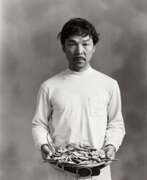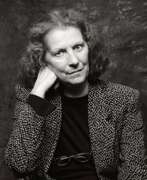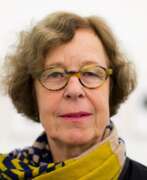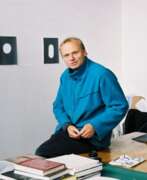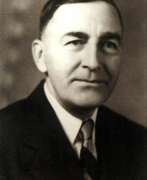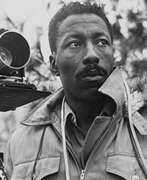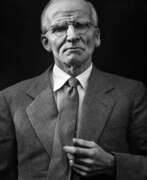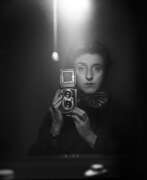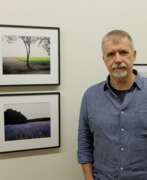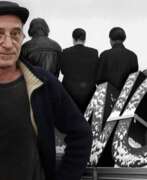Artists Black & white photo
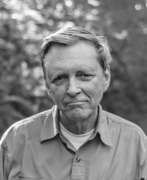

Robert Adams is an acclaimed American photographer known for his profound exploration of the American West's changing landscapes. His work, which gained prominence in the mid-1970s, delves into the tension between the natural beauty of the land and the marks of human encroachment. Adams's photography is a reflection on humanity's relationship with the environment, offering both a critique and a celebration of the landscape.
Robert Adams's notable series, such as "Turning Back" and "The New West," showcase his unique perspective on environmental and urban development issues. His work extends beyond just capturing images; it is a thoughtful commentary on the balance between nature and industrialization. His photographs, often devoid of people, focus on the land itself, telling a story of alteration and resilience.
Exhibitions of Adams's work, such as "American Silence: The Photographs of Robert Adams" at the National Gallery of Art, provide insight into his 50-year career and his ability to capture the silent yet profound narratives of the American landscape. His pieces are part of major collections and have been featured in numerous retrospectives, underlining his influence and significance in the world of photography.
For art collectors and enthusiasts, Robert Adams's work offers a poignant perspective on the American West, blending aesthetic beauty with critical environmental commentary. Engaging with his work invites reflection on our interaction with the landscape and our role in shaping the environment.
If you're interested in staying updated on Robert Adams's work and exhibitions, consider subscribing to newsletters from galleries and museums that feature his art. This way, you'll be informed about new displays of his work and opportunities to engage with his insightful perspectives on the American West.


Ansel Easton Adams was an American photographer and environmentalist, celebrated for his black-and-white images of the American West, particularly Yosemite National Park. His profound connection with nature was not only the subject of his art but also the essence of his environmental advocacy, earning him a revered place in both the art and conservation worlds.
Ansel Adams' early exposure to the beauty of nature and a supportive family environment nurtured his dual interests in music and photography. His photographic journey began with a simple Kodak Box Brownie camera, which he used during his early visits to Yosemite, a place that would become the central theme of his life's work. Ansel Adams' dedication to photography and the environment was interwoven, as he utilized his art to advocate for the conservation of America's natural landscapes.
In the 1930s, Adams co-founded Group f/64, advocating for photographic purity and sharpness of focus, principles that would define his work. His role in establishing the photography department at the Museum of Modern Art in New York underscored his commitment to elevating photography as a respected art form. Ansel Adams' work has been exhibited in prestigious institutions such as the Smithsonian American Art Museum and MoMA, showcasing his contributions to American art and environmentalism.
For collectors and art experts, Ansel Adams' legacy transcends his iconic images; it lies in his ability to merge aesthetic excellence with a passionate message of environmental stewardship. His photographs not only capture the grandeur of landscapes but also serve as a timeless call to preserve the natural world.
To delve deeper into the world of Ansel Easton Adams and stay updated on new product sales and auction events related to his work, signing up for updates is a step toward embracing the heritage of a pivotal figure in art and environmental advocacy.
Join our community of art and antique enthusiasts to honor Adams' vision and ensure his message continues to inspire future generations.


Ellen Auerbach, born Ellen Rosenberg, is an American photographer of German-Jewish descent and a master of avant-garde photography.
Ellen studied at the Baden State School of Art and continued her studies at the Academy of Fine Arts in Stuttgart before meeting photographer Greta Stern (1904-1999) in Berlin. Together they opened Ringl+pit, a photography and design studio specializing in advertising, fashion and portrait photography. The photographer is most remembered for her groundbreaking work at this particular studio. Ellen, who also experimented with film, made two short black-and-white films.
In 1933, Ellen emigrated to Palestine and opened a children's portrait studio there. A few years later she moved with her husband Walter Auerbach to the United States, where she worked in a private art collection, taught photography, made films and photographs to study children's behavior, and worked as an educational therapist.
The Ringl+pit works and photographic oeuvre of Ellen Auerbach and Greta Stern were rediscovered in the 1980s, and a series of solo and group exhibitions in the United States and Germany followed.


Lillian Bassman was an American photographer and artist.
A magazine art director and fashion photographer, she became famous in the 1940s and '50s for her high-contrast, dreamy portraits of sylph-like models. Bassman's unique graphic style of photography illustrates the feminine mystique and glamour, as well as the boldness of an artist who blurs the lines between fashion photography and fine art. Working as art director for Bazaar magazine in 1945, she helped launch the careers of many of the century's most famous photographers.


Bernhard (Bernd) Becher and Hilla Becher were German conceptual artists and photographers working as a collaborative duo. They are best known for their extensive series of photographic images, or typologies, of industrial buildings and structures, often organised in grids. As the founders of what has come to be known as the 'Becher school' or the 'Düsseldorf School' they influenced generations of documentary photographers and artists. They have been awarded the Erasmus Prize and the Hasselblad Award.


Valérie Belin is a French art photographer. She lives and works in Paris.
Her work takes the form of photographic series. In the 2000s she started using digital post-production tools which gave her greater freedom to change and control the chromatic values of the prints. She now produced her first series in colour. In 2009 Belin began to use other kinds of digital manipulation, heightening the hybrid, graphic and artificial dimension of her work. These include solarisation and overprinting. Since then, she has also worked with other abstract vectorial forms, like digital "readymades" found on the internet, which she reworks on the computer, melding them with her images.
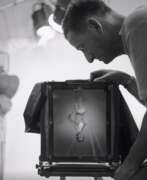

Erwin Blumenfeld was a German-born photographer and artist who is best known for his fashion photography and experimental work in the mid-20th century. He was began his career as an artist, working in painting, drawing, and collage.
In the 1930s, Blumenfeld fled Germany and settled in Paris, where he became a successful fashion photographer. He worked for Vogue and other high-profile magazines, creating iconic images of models and celebrities such as Marilyn Monroe, Elizabeth Taylor, and Grace Kelly.
Blumenfeld was also known for his experimental and avant-garde work, which often involved techniques such as photomontage, solarization, and multiple exposures. He saw photography as a means of artistic expression and used it to explore ideas about identity, beauty, and the nature of reality.
Blumenfeld's legacy as an artist and photographer continues to influence contemporary fashion and art. His innovative techniques and distinctive style continue to inspire new generations of artists, and his work is recognized as a significant contribution to the history of photography.
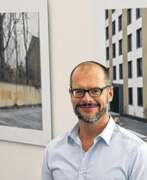

Oliver Boberg is a German artist, working with photography and video, whose work has been exhibited internationally. Mainly reflecting on the process of creating and recalling memories, Boberg's works are in the collections of institutions such as the Victoria & Albert Museum ( London, England) and the Museum of Modern Art (New York, NY).


Guy Bourdin was a French photographer and artist who is best known for his innovative and provocative fashion photography in the mid-20th century. He was began his career as a painter before turning to photography.
Bourdin's photographic style was characterized by his use of bold colors, surreal imagery, and provocative themes. He often incorporated elements of eroticism and violence into his work, challenging traditional ideas about beauty and femininity.
Bourdin's photographs were widely published in fashion magazines such as Vogue, and he became known for his collaborations with fashion designers such as Charles Jourdan and Issey Miyake. His work was highly influential, and he is considered one of the most important fashion photographers of the 20th century.
Bourdin's legacy as an artist and photographer continues to inspire new generations of artists. His innovative techniques and bold aesthetic continue to push the boundaries of fashion photography and have had a significant impact on contemporary art and culture.


Margaret Bourke-White was an American photographer and photojournalist. She studied photography at the Clarence H. White School of Photography. White, where she developed her trademark style using dramatic angles and strong contrasts of light and shadow.
Burke-White was one of the first women photographers to work for Life magazine, and her images became synonymous with the magazine's coverage of major world events such as World War II and the Korean War. She was also the first woman photographer to work in war zones during World War II, where she captured powerful images of warfare and its impact on civilians.
In addition to war photography, Bourke-White also documented the Great Depression in the United States and was one of the few photographers to gain access to the Soviet Union in the 1930s where she documented Soviet industrialization and the lives of ordinary people.
Bourke-White's work was known for its powerful impact and stark realism. She often risked her safety to get the perfect shot and her images continue to inspire photographers today. She published several books of her work, including 'Eyes on Russia' and 'Dear Fatherland, Rest in Peace'.
Bourke-White left behind a legacy as one of the greatest photojournalists of the 20th century.


Cornell Capa is an American photographer, photojournalist and founder of the International Center of Photography (ICP) in New York, the younger brother of the famous war correspondent Robert Capa.
Cornell Capa was known for his humanistic approach to photography, often capturing the lives and struggles of ordinary people. Throughout his career, he covered many important events, including the Spanish Civil War, World War II and the Vietnam War. Capa also photographed many famous people including John F. Kennedy, Marilyn Monroe and Pablo Picasso.
In 1974, Cornell Capa founded ICP, which has since become one of the world's leading photography education and exhibition institutions. The ICP's mission is to promote the understanding and appreciation of photography as an art form as well as a means of communication and social change.
Throughout his career Capa has received numerous awards and honours, including the National Medal of Arts in 1988. His photographs continue to be exhibited in galleries and museums around the world and his legacy lives on through ICP.


Robert Capa is a Hungarian-American photographer and photojournalist. He is considered one of the greatest war photographers of all time, known for his dramatic images of combat and conflict. Cornell Capa's older brother and a classic of documentary photography.
Capa began his career as a photographer in the early 1930s and soon became known for his coverage of the Spanish Civil War. He went on to cover many major conflicts, including World War II, the First Indochinese War and the Arab-Israeli War.
One of Robert Capa's most famous photographs is Falling Soldier, taken during the Spanish Civil War. The photo depicts a Republican soldier as he is shot and falls to his death. The authenticity of the photograph has been the subject of controversy for many years, but it remains an iconic image of war photography.
Capa also co-founded Magnum Photos, which was established in 1947 as a cooperative for independent photographers. Since then Magnum Photos has become one of the most prestigious and influential photo agencies in the world.
Capa died in 1954 while covering the First Indochina War, stepping on a mine. His legacy as a war photographer and photojournalist continues to inspire generations of photographers and his work remains an important part of photographic history.


Ghitta Carell was the professional name of Ghitta Klein, a naturalized Italian photographer, born in Hungary, who came to prominence between 1930 and 1950. Noted for her portraiture, she was a favored photographer among the aristocracy and despite her Jewish heritage she helped build the imagery used in Fascist propaganda. After the fall of Mussolini, she remained in Italy, though her field of influence was greatly diminished. At the end of the 1960s, she immigrated to Israel, where she died in obscurity. Her archives, preserved by the 3M Foundation, have widely toured throughout Europe and a revival of interest in evaluating her skill as a technician has developed in the 21st century.


Henri Cartier-Bresson was a French artist renowned for his groundbreaking work in photography, particularly in the realms of photojournalism and street photography. Born on August 22, 1908, in Chanteloup, France, Cartier-Bresson's early artistic endeavors were in painting, which he began studying at the age of five. His transition to photography was marked by his adoption of a 35mm Leica camera in 1931, a tool that became synonymous with his work.
Henri Cartier-Bresson's photography is celebrated for its unique blend of spontaneity and composition, capturing moments that reveal deeper truths about their subjects. His theory of "the decisive moment" – that is, capturing an event that is ephemeral and spontaneous, yet significant – has had a profound influence on the field of photography. His work has been exhibited in prestigious venues such as the Museum of Modern Art in New York and is held in high esteem in art collections worldwide.
In addition to his personal achievements, Henri Cartier-Bresson was a co-founder of Magnum Photos in 1947, a cooperative agency for worldwide photographers that significantly influenced photojournalism. Later in his career, Cartier-Bresson returned to painting and drawing, demonstrating his lifelong commitment to the arts.
For art collectors and experts, Henri Cartier-Bresson's work offers a pivotal exploration of 20th-century photography, blending artistic vision with the unguarded moments of life. His influence extends beyond his images, shaping the way we perceive and engage with visual narratives.
To explore more about Henri Cartier-Bresson's influential career and works, and to stay updated on exhibitions or sales featuring his photography, you might consider subscribing to updates from art institutions or galleries that frequently showcase his work.


Lucien Clergue is a French photographer of black and white photography, the first photographer elected a member of the French Academy of Fine Arts.
Lucien Clergue is one of the most famous photographers in France and founder of the annual Arles Festival, which has become the main event in the world of artistic photography, attended by up to 100,000 people. His famous photographic works - modernist black and white studies of female nudes, harlequins, dead animals, gypsies and bullfighting - are considered exemplary of the photographer-artist. Clergue is also known for his friendship with Pablo Picasso, which lasted some 30 years, until the artist's death.


Alvin Langdon Coburn was an American photographer and artist who was best known for his pioneering work in the field of pictorial photography. He was a member of the Photo-Secession movement, which was a group of photographers who sought to elevate photography to the status of fine art.
Coburn was born in Boston, Massachusetts, and grew up in England. He began taking photographs when he was just eight years old and later studied photography in New York City. He went on to become one of the leading photographers of his time, and his work was exhibited widely in Europe and the United States.
Coburn is perhaps best known for his innovative use of the "vortograph," a technique he developed in 1917 that involved photographing objects through a triangular arrangement of mirrors. The resulting images were highly abstract and geometric, and anticipated the work of many later artists, including the Surrealists.
In addition to his work in photography, Coburn was also an accomplished painter and printmaker. He continued to work as an artist throughout his life, and his work is now held in the collections of many major museums around the world.


Bruce Landon Davidson is an American photographer. He has been a member of the Magnum Photos agency since 1958. His photographs, notably those taken in Harlem, New York City, have been widely exhibited and published. He is known for photographing communities usually hostile to outsiders.


Alfred Ehrhardt was a universally talented German artist. He was an organist and choirmaster, then a music and art teacher in a remedial school, and finally an art teacher and painter, before becoming a photographer and director.
After spending the winter semester 1928-29 at the Bauhaus Dessau, where he was decisively influenced by Josef Albers, Wassily Kandinsky, Paul Klee and Oskar Schlemmer, he transferred the Bauhaus pre-course concept to his art lessons with children and young people, beginning in first grade and continuing through Abitur. Based on this experimental experience, in 1930 he was appointed to the Landeskunstschule Hamburg, where he created the first preliminary course in materials science outside the Bauhaus. After being dismissed by the National Socialists from the university in 1933 because of his modernist views of art, he turned to photography and film.
Alfred Ehrhardt is considered an outstanding representative of the new objective photography. After publishing more than 20 photobooks, he became one of the most successful photographers among the former Bauhaus artists. His "absolutely artistic films", which defy modernity and are inspired by the avant-garde of the 1920s, place him among the old masters of cultural and documentary cinema. Alfred Erhardt is considered "Germany's most important post-war creator of cultural films" and has received numerous national and international awards for his more than 50 films, including four Federal Film Prizes.


Alfred Eisenstaedt was a German-born American photographer and photojournalist. He is best known for his work as a staff photographer for Life magazine, where he captured iconic images of celebrities, politicians, and everyday people.
Eisenstaedt began his career as a photographer in Germany, working for the Pacific and Atlantic Photos agency in Berlin in the 1920s. He emigrated to the United States in 1935 and joined the staff of Life magazine in 1936, where he remained until the magazine ceased publication in 1972.
Eisenstaedt's images are notable for their candid, spontaneous feel and their ability to capture the essence of his subjects. He is perhaps best known for his photograph "V-J Day in Times Square," which depicts a sailor kissing a nurse in celebration of the end of World War II. The image has become one of the most iconic photographs of the 20th century.
Throughout his career, Eisenstaedt photographed many of the most famous and influential people of his time, including Marilyn Monroe, Albert Einstein, Winston Churchill, and John F. Kennedy. His work has been exhibited in major museums around the world, and he received numerous awards and honors for his contributions to the field of photography.


Elsa and Johanna are a creative duo of photographic artists and filmmakers.
They were finalists for Prix HSBC pour la photographie 2016 and won the second Prix Picto de la mode 2017.
The duo's clients include well-known publications such as Le Temps, Boycott Magazine, L'Express 10, Crash Magazine, Etro, Boucheron and Apple.


Arthur (Usher) Fellig, known by his pseudonym Weegee, was a photographer and photojournalist, known for his stark black and white street photography in New York City.
Weegee worked in Manhattan's Lower East Side as a press photographer during the 1930s and 1940s and developed his signature style by following the city's emergency services and documenting their activity. Much of his work depicted unflinchingly realistic scenes of urban life, crime, injury and death. Weegee published photographic books and also worked in cinema, initially making his own short films and later collaborating with film directors such as Jack Donohue and Stanley Kubrick.
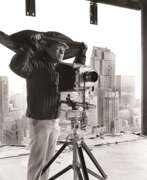

Ormond Gigli was an American photographer best known for his fashion and portrait photography. He was began his career as a freelance photographer in the 1940s, eventually becoming a staff photographer for several major publications, including LIFE, Time, and Harper's Bazaar.
Gigli's work is characterized by its striking use of color and composition, often featuring models in elaborate poses and settings. One of his most famous images is "Girls in the Windows," a photograph he took in 1960 of models posed in the windows of a Manhattan building slated for demolition.
Throughout his career, Gigli received numerous awards and accolades for his work, including the Lifetime Achievement Award from the American Society of Media Photographers in 2003. His photographs have been exhibited in galleries and museums around the world, and are held in the collections of many major institutions, including the Museum of Modern Art in New York and the National Portrait Gallery in Washington, D.C.


Nan Goldin is an acclaimed American photographer renowned for her profound visual narratives that delve into her personal world, marked by themes of addiction, sexuality, and intimate relationships. Born in Washington, D.C., in 1953, Goldin's journey into photography began in the early 1970s, capturing the lives of those around her, forming a "substitute family" amid a backdrop of drugs, sex, and violence.
One of Goldin's most celebrated works, "The Ballad of Sexual Dependency" (1986), is a raw and intimate portrayal of her "tribe," documenting their lives through the late 70s and early 80s in New York City. This work, initially presented as a slideshow, captures moments of love, sexuality, and domestic life, transcending into a poignant narrative of the era's challenges, particularly the AIDS crisis.
Throughout her career, Goldin's photography has continued to evolve, exploring various themes and mediums, including film. Her work, deeply personal and often autobiographical, challenges conventional perceptions of beauty, identity, and relationships, offering a window into the complexities of human connection and the essence of her subjects.
Goldin's influence extends beyond the art world, with her activism, particularly against the opioid crisis, marking another significant chapter in her journey. Her profound empathy and commitment to portraying the raw, unfiltered realities of life resonate through her extensive body of work, which continues to be celebrated in exhibitions and collections globally.
For art collectors and enthusiasts, Goldin's work offers not just aesthetic value but also deep emotional and historical resonance. To stay informed about Nan Goldin's works and related updates, signing up for newsletters from prominent galleries or her exhibitions could provide valuable insights and opportunities for engagement with her art.
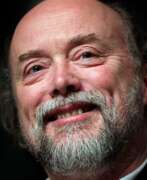

Bill Henson is an Australian photographer. He is known for his moody and atmospheric photographs of the human form, as well as landscapes and architectural interiors.
Henson began his career as a photographer in the 1970s and gained recognition in the 1980s for his moody and enigmatic images of teenagers. His work often explores themes of sexuality, desire, and the subconscious.
Throughout his career, Henson has continued to produce striking photographic works that push the boundaries of conventional portraiture and landscape photography. He has exhibited widely both in Australia and internationally and his work is included in the collections of many major museums, including the National Gallery of Australia, the Museum of Contemporary Art in Sydney, and the Solomon R. Guggenheim Museum in New York.
Henson has also been the recipient of numerous awards and honors for his photography, including the Centenary Medal from the Australian government in 2001 and the Officer of the Order of Australia in 2019.


Todd Hido is an American photographer and artist. He is best known for his moody and atmospheric photographs of suburban landscapes and homes, which often convey a sense of loneliness and isolation.
Hido's photographic style is characterized by his use of muted colors, soft lighting, and blurred images. He often photographs interiors and exteriors of homes at night, creating a dreamlike and eerie mood. His work is also known for its cinematic quality, and many of his images evoke the mood of film noir.
Hido's work has been exhibited in galleries and museums around the world, and his photographs have been published in numerous books and magazines. He has received many awards for his work, including a fellowship from the National Endowment for the Arts.
Hido's legacy as an artist and photographer continues to influence new generations of photographers and artists. His moody and evocative style has had a significant impact on the field of contemporary photography and has helped to redefine the way that we think about suburban landscapes and the concept of home.
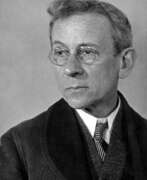

Lewis W. Hine was not an artist in the traditional sense, but rather a photographer and social documentary photographer who used his camera as a tool for social change. He is best known for his work in the early 20th century, documenting the living and working conditions of children in the United States.
Hine's photographs were instrumental in bringing about changes in child labor laws in the United States, and his images were used as evidence in court cases and Congressional hearings. He believed that photography could be a powerful tool for social reform, and he used his camera to highlight the injustices and hardships faced by working-class Americans.
In addition to his work as a photographer, Hine was also a teacher and an advocate for the arts. He taught at the Ethical Culture School in New York City, where he encouraged his students to use photography as a means of social commentary.
Hine's legacy as a photographer and social activist continues to inspire generations of artists and advocates for social justice. His photographs are considered a valuable historical record of life in the early 20th century, and his commitment to using art as a means of social change remains a powerful example of the role that artists can play in shaping society.


Dennis Lee Hopper was not only a prominent figure in the American film industry but also an accomplished photographer whose work captured the essence of a transformative era in the United States. Hopper's artistic journey spanned various mediums, with photography holding a special place in his array of talents. His photographic career, which began in earnest during the 1960s, offers a compelling glimpse into the cultural and social landscapes of the time.
Dennis Lee Hopper's photography is celebrated for its raw, candid portrayal of his surroundings, capturing moments that range from the intimate to the chaotic. His images provide a personal narrative of his life and times, reflecting his connections with key cultural and artistic figures of the era. His work is not just a collection of images but a visual diary, chronicling the vibrant and often tumultuous world he inhabited.
Notably, Dennis Lee Hopper's photographic portfolio offers an invaluable perspective on the American counterculture movement, showcasing his keen eye for composition and his ability to capture the spirit of the moment. His photographs, including portraits of famous contemporaries and snapshots of street scenes, resonate with authenticity and artistic integrity.
For collectors and enthusiasts in the realms of art and antiques, Dennis Lee Hopper's photographs represent a unique convergence of cinematic and photographic artistry. His works not only capture moments in time but also evoke the broader cultural shifts of his era. For those interested in exploring Hopper's photographic legacy, staying informed about exhibitions and auctions can provide opportunities to engage with his work more deeply and appreciate his contribution to the art of photography.
To stay updated on Dennis Lee Hopper's photographic works and related events, subscribing to updates from art galleries and auction houses is recommended. This subscription will provide timely information on new exhibitions, sales, and insights into Hopper's impact on the world of photography and art.
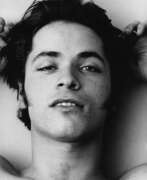

Peter Hujar was an American photographer best known for his black and white portraits. He has been recognized posthumously as a major American photographer of the late-twentieth century. Yet Hujar's work received only marginal public recognition during his lifetime.


Walde Huth, née Waldberta Huth, is a German photographer known for her street photos and portraits of famous people and fashion models.
She graduated from the State School of Applied Arts in Weimar, and after World War II she became a freelance photographer doing portrait and art photography. Walde Huth is primarily known for her fashion shots of the '50s, she also took unique stills and advertising photos, and created portraits of famous contemporaries. Her iconic fashion shots were taken in Paris. She shot the most famous models of her time not in the studio, but on location in the city, in front of the Eiffel Tower, along the Seine River, in contrast to the architecture and street life.
Walde Huth was an exceptional woman, a creative artist and a versatile photographer.


Johann Baptist Isenring was a Swiss landscape painter and printmaker, one of the first photographers in 19th-century Switzerland.
Johann studied painting and aquatint at the Munich Academy of Fine Arts, opened an art studio in St. Gallen in 1828 and soon began publishing his lithographic collection of picturesque views of Switzerland's most remarkable cities and towns.
In 1839, Isenring, fascinated by the discoveries of Niépce and Daguerre, bought equipment for "daguerreotype" and a year later organized an exhibition in his studio in Multtertor, which was probably the first photographic exhibition in the world. Isenring even gave up painting for a while and worked as a photographer for two years, settling in Munich. He made portraits, photographs of architecture, reproductions of paintings and developed a coloring method for his prints, which he patented in America.


Colette Justine, better known as Colette Lumiere, is a Tunisian-born, American multimedia artist known for her pioneering work in performance art, street art, and her use of photography to create photographic tableau vivant. She is also known for her work exploring male and female gender roles, use of guises and personas, and for soft fabric environments, where she often appears as the central element.


Carl Christian Heinrich Kühn was an Austrian–German photographer and photography pioneer.
Heinrich Kühn is regarded one of the forefathers of fine art photography, the movement that helped photography to establish itself as an art on its own. His photographs closely resemble impressionist paintings, with their frequent use of soft lighting and focus. Kühn was part of the pictorialist photographic movement.
Kühn mainly used the gum bichromate technique, applied in several layers, and thus allowing for previously unseen color tonalities.


Helen Levitt was an American photographer known for her street photography of New York City. Levitt began taking photographs as a teenager and went on to work for the photo agency, the Photo League, in the 1930s and 1940s.
Levitt's work focused on capturing the daily lives of ordinary people, particularly children, in the neighborhoods of New York City. She used a small 35mm camera to take candid shots of children playing in the streets, creating images that were both playful and poignant. Her work was often compared to the work of fellow street photographers, such as Henri Cartier-Bresson and Walker Evans.
In addition to her photography, Levitt also worked as a filmmaker and created several acclaimed documentaries.
Levitt's photographs have been exhibited in major museums around the world, including the Museum of Modern Art in New York and the San Francisco Museum of Modern Art. She was awarded numerous honors for her work, including a Guggenheim Fellowship and a National Endowment for the Arts Grant.


Vera Lutter is a German artist based in New York City. She works with several forms of digital media, including photography, projections, and video-sound installations. Through a multitude of processes, Lutter's oeuvre focuses on light and its ability to articulate the passing time and movement within a tangible image.


Christopher Makos is an American photographer and artist living and working in New York City.
Makos has traveled extensively in Europe, studied architecture in Paris, and studied with photographer Man Ray. In 1977 he met media artist and pop art star Andy Warhol and has been friends, traveled with him and photographed him extensively ever since. Makos published several acclaimed books on Warhol, and the latter called Makos "the most modern photographer in America."
In addition to him, Makos took photographic portraits of many art stars, including Elizabeth Taylor, Salvador Dali, John Lennon and Mick Jagger. His work has been published by many of the world's most famous magazines.


Robert Mapplethorpe was an American photographer, celebrated for his black-and-white photographs that captured a range of subjects including celebrity portraits, male and female nudes, self-portraits, and still-life images. Born in New York in 1946, Mapplethorpe's work is renowned for its technical precision, formal elegance, and controversial content, particularly his documentation of the gay male BDSM subculture and his erotic art. His body of work not only includes provocative themes but also more traditional subjects like flowers, showcasing his versatile artistic talent.
Robert Mapplethorpe's education at Pratt Institute in Brooklyn was foundational to his artistic journey, where he met Patti Smith and began his explorations in photography, initially through Polaroid camera use before advancing to more sophisticated techniques. His collaboration with Lisa Lyon, the first World Women's Bodybuilding Champion, and his retrospectives at significant institutions like the Whitney Museum of American Art highlight his broad artistic impact and continued influence in the art world. Despite his premature death in 1989 due to complications from AIDS, Mapplethorpe's legacy endures, supported by the Robert Mapplethorpe Foundation which promotes photography and funds medical research.
For collectors and experts in art and antiques, Robert Mapplethorpe's work remains a testament to the power of photography as a medium of both aesthetic beauty and provocative commentary. To stay updated on sales and auction events related to Robert Mapplethorpe's works, sign up for updates to not miss out on owning a piece of this influential artist's legacy.
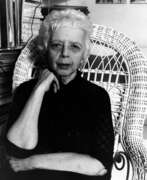

Lisette Model was an Austrian-born photographer who became known for her work in the United States in the mid-20th century. She was began her artistic career as a pianist before turning to photography.
Model's photographic style was characterized by her use of high-contrast black and white images and her interest in capturing the grit and energy of urban life. She often photographed people on the margins of society, such as street vendors, beggars, and nightclub performers, and her images were marked by a sense of empathy and intimacy with her subjects.
In addition to her work as a photographer, Model was also a teacher, and she taught photography at the New School for Social Research in New York City for many years. Her students included Diane Arbus and Bruce Weber, among others, and she was known for her direct and often challenging approach to teaching.
Model's work has had a significant impact on the field of photography, and her legacy continues to inspire new generations of artists. Her photographs are prized for their emotional intensity and their ability to capture the complexities of human experience, and she is remembered as one of the most important photographers of the 20th century.


Stefan Moses was a German photographer living in Munich.
His documentary portraits of people and professions in West Germany (Germans) and later in East Germany (Farewell and Beginnings) made him accessible to a large audience. Moses took people out of their working environment and photographed them in front of a grey linen cloth — thus creating contemporary documents.


Gaspard-Félix Tournachon, known by his pen name Nadar, is a French photographer, cartoonist, journalist, writer and balloonist.
Throughout his career, Nadar shot portraits of many famous personalities, including writers, artists, musicians and politicians. Among them were Victor Hugo and Charles Baudelaire, Sarah Bernhardt and George Sand. Nadar's portraits were in great demand as he had a unique ability to reveal the inner essence of his subjects, revealing their character and emotions.
In addition to portraiture, Nadar was an aerial photographer, using hot air balloons to capture breathtaking images from high above. His boldness and adventurous spirit led him to explore new perspectives and techniques, making a significant contribution to the development of aerial photography. In 1858, he became the first person to take aerial photographs.


Helmut Newton (born Helmut Neustädter) was a German-Australian photographer. The New York Times described him as a "prolific, widely imitated fashion photographer whose provocative, erotically charged black-and-white photos were a mainstay of Vogue and other publications."


Carmen Oberst is a German artist, graphic designer and photographer.
She has lived in Hamburg since 1980 and works as an independent photographic artist, curator and teacher of design using photographic media.
Carmen Oberst originally worked as a graphic designer. Since 1997 she has been active in photography and experimental film, holding numerous exhibitions at home and abroad. Back in the 1980s, she developed her own visual language based on analog black and white photography and photoalchemical experiments. And in 1996 she founded PHOTO.KUNST.RAUM, a center for fine art photography and fine art known outside Hamburg.
Carmen Oberst turns the world into a stage: she routinely uses found events and randomly present people to create a fantastical production from the group of works "Rods of Imagination - On the Road" through the medium of photography.


Jacques Olivar is a Moroccan fashion and advertising photographer and filmmaker.
In his youth he worked as a pilot of passenger air transport, but by the age of 40 he finally realized that photography is his vocation. And he became successful quite quickly. Since 1987, fashion photography has become his main profession. Jacques Olivar works for leading fashion magazines and has won many awards.
Emotion, elegance and beauty are the invariable key elements underlying Jacques Olivar's photographic works. The black and white images create an atmosphere of neorealism, while the color images seem to reference the heyday of cinema and build on the idea of the "American Dream".


Norman Parkinson was a renowned British photographer who is considered one of the most influential fashion photographers of the 20th century. Parkinson began his career in the 1930s and continued to work until his death.
Throughout his career, Parkinson worked for numerous fashion magazines, including Vogue, Harper's Bazaar, and Queen. He was known for his use of vibrant colors and his ability to capture his subjects in dynamic poses and interesting settings. Parkinson's photographs often had a sense of humor and playfulness, and he was known for his ability to put his models at ease, resulting in natural and spontaneous photographs.
Parkinson's work has been exhibited in galleries and museums around the world, and he has been the subject of numerous books and documentaries. He received numerous awards throughout his career, including the Royal Photographic Society's Centenary Medal in 1985.


Edward Quinn is an Irish photographer famous for his portraits of celebrities and artists.
Edward Quinn began his career as a photojournalist, covering events such as the Spanish Civil War and the Second World War. In the 1950s he moved to the French Riviera and began photographing the rich and famous — Pablo Picasso, Brigitte Bardot, Grace Kelly, Max Ernst, Alexander Calder, Francis Bacon, Salvador Dali, Graham Sutherland, David Hockney.
Quinn's photographs are noted for their naturalness and spontaneity. He had a talent for capturing his subjects in inconspicuous moments and revealing their true essence. His portraits often show his subjects relaxed and at ease, as if they were unaware of the camera's presence.
In addition to photography, Quinn was also a writer and filmmaker. He wrote several books about the French Riviera and made a documentary about Pablo Picasso.


JR (French: Jean René) is the pseudonym of a French photographer and artist who does not give his full name. He lives and works in Paris and New York.
He describes himself as a "photograffeur" (photographer and graffiti artist in one word) and claims that the street is "the biggest gallery in the world". His work is flyposting large black and white images in public spaces. JR works at the intersection of photography, street art, filmmaking and social activism. Over the past two decades he has developed many public projects in cities around the world, from buildings in the slums of Paris to walls in the Middle East and Africa or favelas in Brazil.
JR places large-scale photographic images in public spaces. He started creating graffiti as a teenager on the streets and rooftops of Paris and on the subway. In 2007, he gained worldwide attention by placing huge photographs of Israelis and Palestinians face to face in eight Palestinian and Israeli cities on both sides of the separation barrier. In his works, the photographer always addresses current political and social issues in the world. For example, in 2019, JR worked with a group of inmates of a maximum security prison in California and created a large format piece with portraits of the inmates.
JR has traveled to many cities with his work, participating in exhibitions, he has collaborated with magazines and created films about his work. JR has also directed three feature-length documentaries, one of which, Women Are Heroes (2011) was nominated for an Oscar. At the 2017 Cannes Film Festival, he won the Golden Eye for Best Documentary.


Werner Rohde, a German artist, was notably multifaceted, delving into photography, stained-glass painting, and drawing. He embarked on his photographic journey in 1927 while studying at the Kunstgewerbeschule at Burg Giebichenstein in Halle, under notable mentors like Erwin Hahs and Hans Finsler. Werner Rohde's artistic vision expanded after his encounter with László Moholy-Nagy, leading him to experiment with double exposures, unique camera angles, and inventive lighting effects, which distinguished his work in the realm of photography.
Werner Rohde's contributions were recognized during his lifetime, particularly in 1929 when his works were featured in the influential Film und Foto exhibition in Stuttgart. His personal life, especially his relationship with his future wife and frequent model, fashion designer Renata Bracksieck, deeply influenced his work, providing a recurring subject that added a personal dimension to his artistic expressions.
Post-World War II, Werner Rohde's career took a different turn as he assumed the mantle of his father's glass painting studio in Worpswede, a shift that reflects the diverse range of his artistic talents. Despite the changes in his artistic mediums over the years, Rohde's early work in photography continued to hold a significant place in art history, evident from the enduring interest in his works in exhibitions and digital collections like those at the Städel Museum.
For collectors and art enthusiasts, Werner Rohde's work offers a captivating glimpse into the innovative photographic techniques of the early 20th century, reflecting a blend of artistic vision and technical skill that continues to inspire. To stay updated on exhibitions and opportunities to engage with Rohde's work, consider subscribing to updates from galleries and museums that feature his art.


Edward Ruscha, an American artist born in 1937, is a prominent figure associated with West Coast Pop art, celebrated for his innovative approach to blending visual and verbal language within his works. Ruscha's journey in the art world began after moving to Los Angeles in 1956, where his fascination with the urban landscape and commercial culture flourished. He attended Chouinard Art Institute, now known as CalArts, which laid the foundation for his artistic exploration.
Edward Ruscha's art is deeply influenced by the Hollywood film industry, with works like "Large Trademark with Eight Spotlights" echoing the commercial graphics and cinematic influence of his time. His "Word paintings" series, starting in the 1960s, showcases his unique approach to typography and language, setting monosyllabic words against solid backgrounds, a style that continued to evolve throughout his career.
During the 1970s, Edward Ruscha expanded his narrative, incorporating phrases into his works, further exploring the relationship between text and image. His work in the 1980s and beyond includes landscapes juxtaposed with text, creating intriguing visual narratives that challenge viewers to find connections between the words and the images.
Edward Ruscha's contributions to the art world are significant, with his works held in major collections and institutions. His career spans various mediums, including painting, printmaking, photography, and artist's books, showcasing his versatility and enduring influence on contemporary art.
For enthusiasts and collectors of modern art, Edward Ruscha's works offer a unique blend of visual artistry and linguistic play. His innovative approach to combining text and image has cemented his status as a pivotal figure in contemporary art. To stay updated on the latest exhibitions, sales, and insights related to Edward Ruscha's art, consider subscribing to updates from renowned art galleries and auction houses. This subscription will ensure you're informed about new opportunities to engage with and appreciate the distinct and influential art of Edward Ruscha.


Karl Hugo Schmölz was a German photographer.
In collaboration with the great Rhineland architects of his time, including Adolf Abel, Bruno Pohl, Dominik Böhm, Gottfried Böhm, Hermann von Berg, Wilhelm Riefan, Rudolf Schwarz, Hans Schilling, Joachim Schürmann, he created an impressive series of images of the post-war architecture of Cologne. The compilations included shots of architecture, interiors and the city at night. In addition, Schmölz worked with various companies on advertising, especially in the furniture industry.


Linn Schröder is a German photographer living and working in Hamburg and Berlin.
Schröder studied at the HAW University Hamburg, then went on to study at the Hochschule für Arbeitsgemeinschaft in Hamburg, specializing in communication design/photography, and the Gestalt School in Zurich.
Her works often deal with the relationship between dream and reality, they are like a record of memories. Some of Linn Schröder's series are based on family photographs. The images in her photo series "I Think and Family Photographs" deal with one of the most original tasks of photography - to capture and preserve memories.
Many of the photographer's works have won numerous awards and have been shown repeatedly throughout Europe. Linn Schröder collaborates with international magazines and regularly teaches at the Berlin-Weißensee School of Art, the HTW Berlin Institute and the Ostkreuzschule for Photography, among others. Several books have been published on Schröder's work.


Jeanloup Sieff was a French photographer distinguished for his portraits, landscapes, and notably, his nudes. Born on November 30, 1933, in Paris, Sieff was known for his mastery in the use of black and white film, and his skillful use of wide-angle lenses and dodging techniques in the darkroom. His career spanned various fields, including fashion photography, where he was particularly prolific, contributing to major publications such as Elle.
Sieff's education at the École Vaugirard in Paris and the École Supérieure d’arts appliqués in Vevey, Switzerland, laid the foundation for a career that would be marked by an elegant integration of surrealism into his works, reminiscent of Man Ray's influence. He began as a freelance photojournalist in 1954 before later turning his lens towards fashion.
Sieff's photographs, characterized by an ethereal quality and a certain timelessness, continue to be celebrated in exhibitions and collections around the world. His work is not only a study of form and contrast but also an exploration of the subtle interplay of light and shadow.
For those interested in the evolution of photography, particularly in the realm of fashion and portraiture, Jeanloup Sieff’s work stands as an important bridge between the classic and the modern. His images remain a source of inspiration for photographers and a subject of admiration for collectors and art lovers globally.


Laurie Simmons is an American artist, photographer and filmmaker. Since the mid-1970s, Simmons has staged scenes for her camera with dolls, ventriloquist dummies, objects on legs, and people, to create photographs that reference domestic scenes. She is part of The Pictures Generation, a name given to a group of artists who came to prominence in the 1970s. The Pictures Generation also includes Cindy Sherman, Barbara Kruger, and Louise Lawler.


Dayanita Singh is an Indian photographer whose primary format is the book. She has published fourteen books.
Singh's art reflects and expands on the ways in which people relate to photographic images. Her later works, drawn from her extensive photographic oeuvre, are a series of mobile museums allowing her images to be endlessly edited, sequenced, archived and displayed. Stemming from her interest in the archive, the museums present her photographs as interconnected bodies of work that are full of both poetic and narrative possibilities.








































